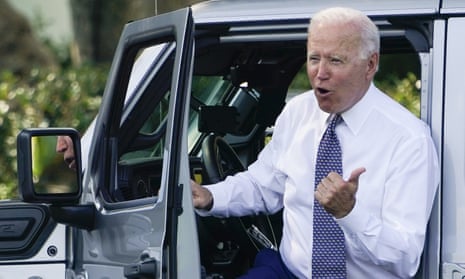Joe Biden is setting a goal for half of all new US vehicle sales to be electric by 2030 while also tightening pollution standards for cars and trucks, in a barrage of action aimed at reducing the largest source of planet-heating gases in America.
On Thursday, the White House outlined its plan to tackle the climate crisis by cutting emissions from vehicles, with Biden set to sign an executive order demanding that 50% of all new cars and trucks sold by the end of the decade be powered by electric batteries.
At the White House with car makers and unions on Thursday, Biden said the future of the car industry is “electric and there is no turning back.”
“The question is whether we will lead or fall behind in the race for the future,” said the president, who stood in front of two electric SUVs. “We used to lead in this technology and we can lead again, But we need to move fast. The rest of the world is moving ahead, we’ve just got to step up.”
The Environmental Protection Agency (EPA) and US department of transport, meanwhile, are unveiling new fuel efficiency standards for vehicles to bolster pollution rules that were weakened under Donald Trump’s presidency. From 2023, new cars will be required to emit 10% less greenhouse gas emissions compared to the previous year, with further reductions of 5% a year mandated until 2026.
Michael Regan, administrator of the EPA, said the new vehicle pollution standards were “a major step forward in delivering on president Biden’s ambitious agenda to address the climate crisis and create good paying, union jobs”.
The crafting of this strategy follows months of talks between the Biden administration and major car manufacturers and, the White House hopes, be paired with a new infrastructure bill that will fund a major upgrade in electric charging points across the US. The administration said the move will reduce CO2 emissions by 2bn tons, save 200bn gallons of gasoline and save drivers several hundred of dollars in fuel savings.
“The importance of these new vehicle emission standards is hard to overstate,” said Dan Lashof, director of the World Resources Institute. “Along with the infrastructure investments currently under consideration in Congress, these standards will be among the most impactful measures that the Biden administration can take to address the climate crisis.”
Trump’s rollback of clean car standards were initially welcomed by the auto industry but many car makers have since indicated a willingness to focus more on electric vehicles. Executives from Ford, GM, Stellantis, formerly Fiat Chrysler, as well as the United Auto Workers (UAW) union will appear with Biden at a White House event on Thursday to back the changes.
Electric vehicles comprised less than 2% of all car sales in the US last year, with many Americans still preferring large, carbon-intensive SUVs. However, electric vehicle sales are rising quickly and manufacturers have started to bring out an array of new models – in May, Ford, which has said 40% of its sales will be electric by 2030, unveiled a battery-driven version of its F-150 model, which has been America’s best selling vehicle since the 1980s.
A joint statement by Ford, GM and Stellantis said that the companies were aiming for 40% to 50% of electric sales by 2030. “This represents a dramatic shift from the US market today,” the statement read, adding that this could only be achieved if the federal government is able to provide incentives to buy electric cars, invest new charging infrastructure and bolster research and development funding.
Some climate advocates argue that the US president’s measures do not go far enough, as the fuel efficiency standards reflect those of California, which struck a compromise deal with car makers in the Trump era, rather than impose a major upgrade on the previous standards.
“We already lost out on four years of climate progress under Donald Trump, and we can’t afford to lose any more time,” Becca Ellison, deputy policy director at Evergreen Action. “In order to meet our climate goals and build a future with more good jobs and less toxic pollution, president Biden should be championing a much faster transition to electric vehicles.”
Biden has set a goal for the US to hit net zero emissions by 2050, a target that experts say will only be reached if America phases out sales of gasoline and diesel cars by around 2035. Campaigners want the president to quickly call time on the internal combustion engine. “Biden cannot think of himself as the climate president with a 50% electric vehicles goal,” said Varshini Prakash, executive director of Sunrise Movement.
“FDR didn’t set a goal to half win the war, and JFK didn’t set a goal to get halfway to the moon.”
